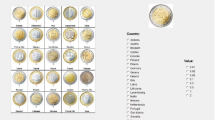Abstract
This paper reports on the use of carrot (positive) and stick (negative) incentives as methods of increasing effort among members of work teams. We study teams of four members in a laboratory environment in which giving effort towards the team goal is simulated by eliciting voluntary contributions towards the provision of a public good. We test the efficiency-improving properties of four distinct environments: monetary prizes given to high contributors versus monetary fines assessed to low contributors, where high/low contributor is defined first in terms of absolute contributions and then in terms of contributions relative to abilities—which we call handicapping. Our results show that both carrot and stick can increase efficiency (i.e., contributions) levels by 10–28%. We find that handicapped incentives promise the highest efficiency levels, and when handicapping is not used penalties may be more effective than prizes. The implications for work teams and suggestions for practical implementation are discussed.
Similar content being viewed by others
References
Alchian, A. and Demsetz, H. (1972). “Production, Information Costs, and Economic Organization.” American Economic Review. 62, 777–795.
Bull, C., Schotter, A., and Weigelt, K. (1987). “Tournaments and Piece Rates: An Experimental Study.” Journal of Political Economy. 95, 1–33.
Carpenter, J. (2000). “Punishing Free Riders: The Role of Monitoring Group Size, Second-Order Free-Riding and Coordination.” Mimeo, Middlebury College.
Dickinson, D.L. (1998). “The Voluntary Contributions Mechanism with Uncertain Group Payoffs.” Journal of Economic Behavior and Organization. 35, 517–533.
Dickinson, D.L. (1999). “An Experimental Examination of Labor Supply andWork Intensities.” Journal of Labor Economics. 17(4) Part 1, 638–670.
Dickinson, D.L. and Isaac, R.M. (1998). “Absolute and Relative Rewards for Individuals in Team Production.” Managerial and Decision Economics. 19, 299–310.
Fehr, E. and Gächter, S. (2000). “Cooperation and Punishment in Public Goods Experiments.” American Economic Review. 90(4), 980–994.
Isaac, R.M. and Walker, J.M. (1988b). “Communication and Free-Riding Behavior: The Voluntary Contributions Mechanism.” Economic Inquiry. 26, 585–608.
Kahneman, D. and Tversky, A. (1979). “Prospect Theory: An Analysis of Decision Under Risk.” Econometrica. 47(2), 263–291.
Lazear, E. and Rosen, S. (1981). “Rank-Order Tournaments as Optimal Labor Contracts.” Journal of Political Economy. 89, 841–864.
Lublin, J.S. “My Colleague, My Boss.” The Wall Street Journal. April 12, 1995, pR4 col. 1.
Nalbantian, H.R. and Schotter, A. (1997). “Productivity Under Group Incentives: An Experimental Study.” American Economic Review. 87, 314–341.
Ostrom, E., Walker, J., and Gardner, R. (1992). “Covenants with and Without a Sword: Self-Governance is Possible.” American Political Science Review. 86, 404–417.
Palfrey, T.R. and Rosenthal, H. (1991). “Testing for Effects of Cheap Talk in a Public Goods Game with Private Information.” Games and Economic Behavior. 3, 183–220.
Pryor, F.L. (1984). “Incentives in Manufacturing: The Carrot and the Stick.” Monthly Labor Review. 107(7), 40–43.
Schotter, A. and Weigelt, K. (1992). “Asymmetric Tournament, Equal Opportunity Laws, and Affirmative Action: Some Experiment Results.” Quarterly Journal of Economics. 107, 511–539.
Sefton, M., Shupp, R., and Walker, J. (2000). “The Effect of Rewards and Sanctions in Provision of Public Goods.” Working Paper, Indiana University Center on Philanthropy and Workshop in Political Theory and Policy Analysis.
van Dijk, F., Sonnemans, J., and vanWinden, F. (2001). “Incentive Systems in a Real Effort Experiment.” European Economic Review. 45(2), 187–214.
Author information
Authors and Affiliations
Rights and permissions
About this article
Cite this article
Dickinson, D.L. The Carrot vs. the Stick in Work Team Motivation. Experimental Economics 4, 107–124 (2001). https://doi.org/10.1023/A:1011449606931
Issue Date:
DOI: https://doi.org/10.1023/A:1011449606931




